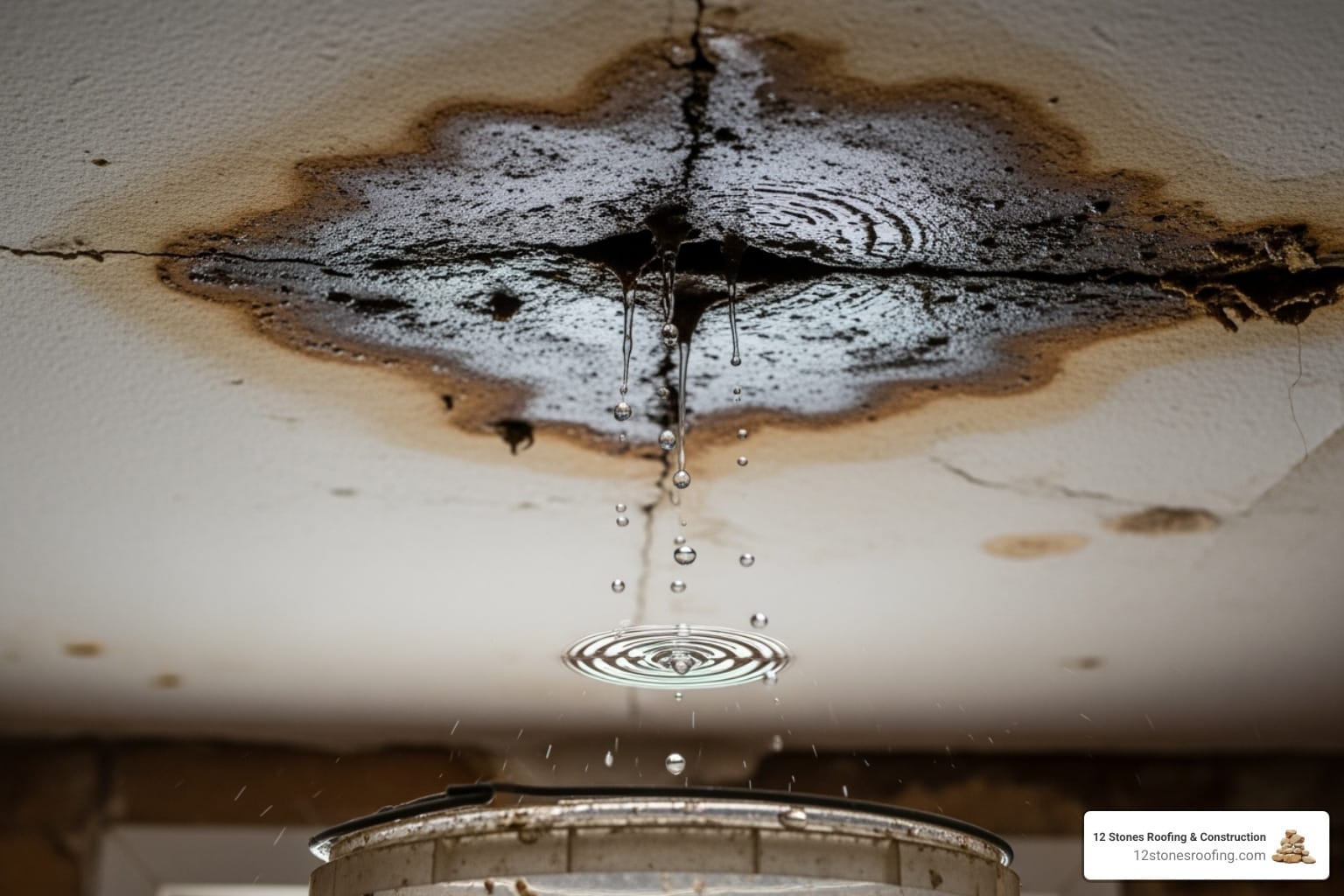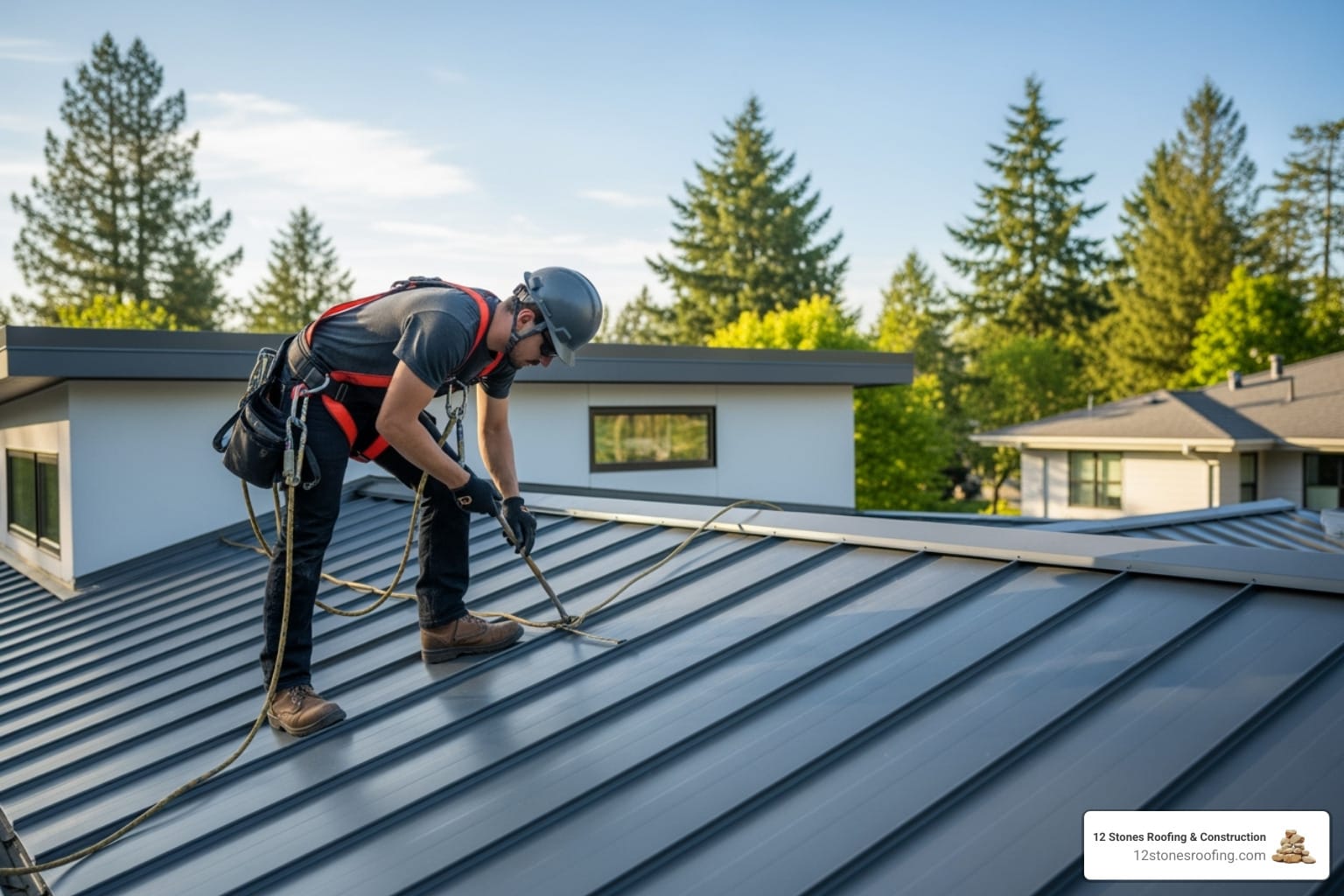Why Rain is Your Roof’s Most Persistent Threat
Roof damage from rain is one of the most common and insidious problems homeowners face. Unlike dramatic storms, consistent rainfall works quietly to compromise your roof’s integrity. Here’s what you need to know:
- Water intrusion accounts for over 70% of construction litigation nationwide.
- Persistent rain accelerates wear by eroding granules, loosening shingles, and promoting moss and algae growth.
- Leaks rarely start where they appear—water can travel along rafters before showing up as ceiling stains.
- Early detection is critical—small leaks caught quickly cost hundreds to fix, while delayed repairs can require thousands in structural restoration.
Many homeowners find their roof’s vulnerabilities only after a heavy rainstorm reveals water stains. By then, the damage has often spread far beyond what’s visible. This guide will walk you through how rain damages your roof, the warning signs to watch for, and the preventive steps that can save you thousands. Whether you want to protect your current system or are dealing with an aging roof, understanding rain’s impact is the first step in protecting your home with our comprehensive residential and commercial roofing services. It’s essential for preventing costly water damage repair needs.
I’m Jason Roberts, owner of 12 Stones Roofing & Construction. For over a decade, I’ve helped Gulf Coast property owners address roof damage from rain and severe weather. Our team has seen how consistent rainfall in the Houston and Pasadena area can devastate unprepared roofs, and we’ve developed proven strategies to prevent and repair this damage.
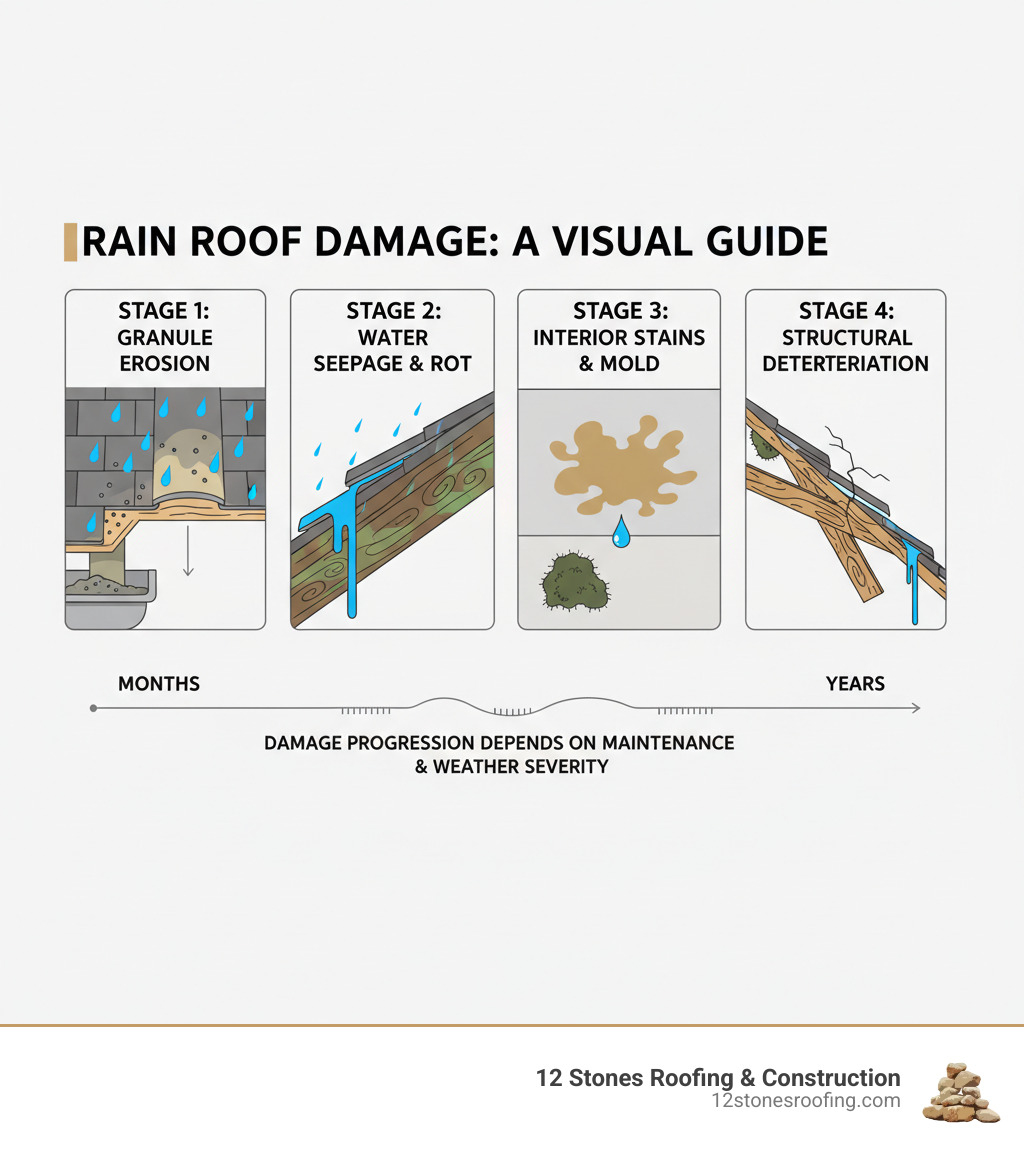
The Silent Attacker: How Consistent Rain Causes Roof Damage
Consistent rainfall doesn’t just wash your roof clean; it actively works to break it down. This slow, persistent attack compromises your roof in several ways, often going unnoticed until water starts dripping through your ceiling. Understanding these mechanisms is the first step toward protecting your home.
Granule Erosion: The Protective Shield Wears Away
Have you ever noticed coarse, dark sand in your gutters? Those are the protective small granules from your asphalt shingles, and their presence is a warning sign. These granules shield the underlying asphalt from weather and UV rays. Heavy or persistent rain washes them away, like sandpaper on wood. Once the granules are gone, the exposed asphalt bakes in the sun, becomes brittle, and cracks. This accelerated aging is a common form of roof damage from rain that often goes unnoticed until your roof has lost years of its lifespan.
Shingle Damage: When Moisture Takes Its Toll
Prolonged exposure to moisture causes asphalt shingles to absorb water, leading to warping, curling, or cracking. Each distortion creates a pathway for water to slip underneath, compromising the roof’s watertight seal. This problem is particularly common with older asphalt shingle roofing. As shingles age, they become more vulnerable to moisture damage. Once they begin to curl or crack, they are also more susceptible to wind uplift, which can peel them off the roof and invite leaks.
Moss & Algae Growth: A Green (But Not Good) Problem
Dark streaks or fuzzy green patches on your roof are more than cosmetic. Consistent dampness creates a breeding ground for moss, algae, and mold, especially in shaded areas. While algae may only stain shingles, moss is more destructive. It acts like a sponge, holding moisture against the roof surface long after rain stops. This constant dampness can cause shingles to lift, crack, or rot. As moss spreads, its root-like structures work under shingles, creating entry points for water and leading to widespread roof damage from rain.
Material Vulnerabilities: Not All Roofs Are Created Equal
Different roofing materials respond to rain in unique ways. Understanding your roof’s specific vulnerabilities helps you know what to watch for.
- Asphalt shingles face granule loss, curling, cracking, and moss growth. Proper maintenance is key to reaching their typical 20 to 25-year lifespan.
- Metal roofs offer exceptional durability, with lifespans of 40 to 80 years. Metal roofs last two to three times longer than traditional materials and are engineered to prevent damage from wind-driven rain. However, scratches in the protective coating can lead to corrosion.
- Tile roofs can last 50 years or more, but the tiles can crack from impacts or absorb water over time. The mortar holding them can also deteriorate, allowing water to seep underneath. Regular inspections are crucial to replace damaged tiles before they cause leaks.
Every roofing material has strengths and weaknesses. Knowing your roof’s vulnerabilities allows you to take targeted action to prevent damage.
From Drip to Disaster: Understanding the Full Impact of Roof Damage from Rain
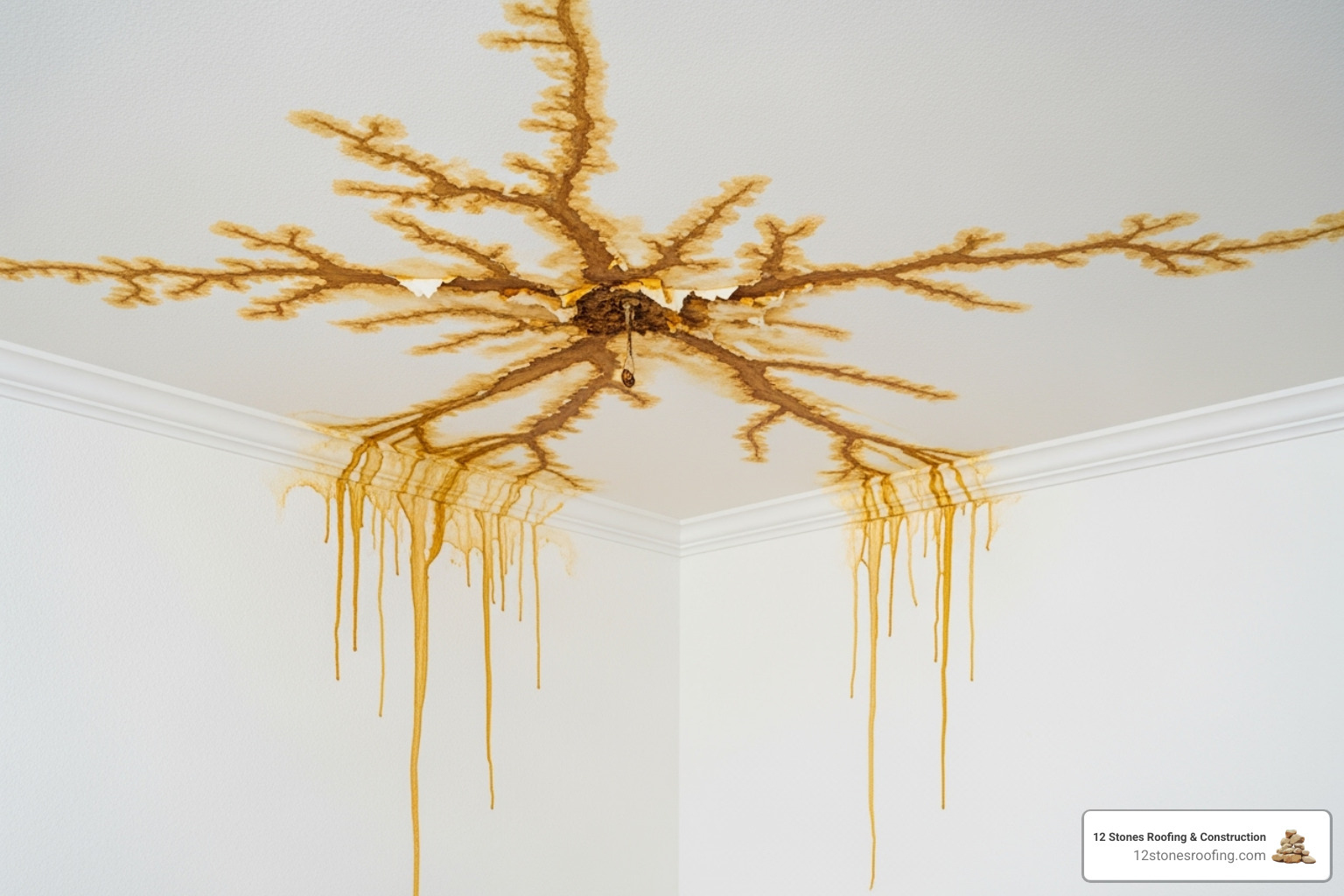
A small leak can quickly escalate into a major catastrophe. On average, roofs last only about half their designed lifetime, often due to delayed maintenance. When you ignore roof damage from rain, the consequences can be devastating and expensive.
When Water Finds Its Way Inside
Once water breaches your roof, it begins a destructive journey. The visible drip is only the start. Water ruins ceilings with brown stains, softens drywall until it collapses, and warps flooring. Your belongings—furniture, electronics, and heirlooms—are all at risk of being destroyed by a single leak.
The Hidden Enemy: Structural Rot
What you can’t see is often the most dangerous. Persistent moisture from roof damage from rain attacks the wooden skeleton of your home. Your roof deck, rafters, and ceiling joists begin to rot, weakening the very framework that supports your roof. This is structural deterioration that compromises your home’s integrity. A visibly sagging roofline signals serious trouble requiring immediate professional attention. What might have been a simple fix can transform into a major structural restoration project costing thousands.
Breathing Danger: The Mold Problem
Trapped moisture in dark, poorly ventilated spaces like your attic creates a perfect environment for mold and mildew. Toxic black mold can proliferate rapidly, posing serious health risks, particularly for anyone with respiratory issues or allergies. A persistent damp or musty odor, even without visible leaks, is a strong indicator of hidden mold growth that requires immediate action.
Fire and Electricity: A Dangerous Mix
Water and electricity are a hazardous combination. When water from a roof leak contacts electrical wiring or fixtures, it creates a significant fire hazard. Water can cause short circuits that damage your entire electrical system. This risk demands immediate professional attention.
Your Energy Bills Tell the Story
When attic insulation gets wet from a roof leak, it compresses and loses its thermal properties. Your HVAC system then works overtime to maintain comfortable temperatures, causing your energy bills to climb. Wet insulation also becomes another breeding ground for mold, perpetuating a cycle of damage and health risks. If you suspect a leak has compromised your insulation, seeking professional Water Damage Repair immediately can prevent these problems from spiraling out of control.
Spotting the Red Flags: A Homeowner’s Guide to Identifying Rain Damage
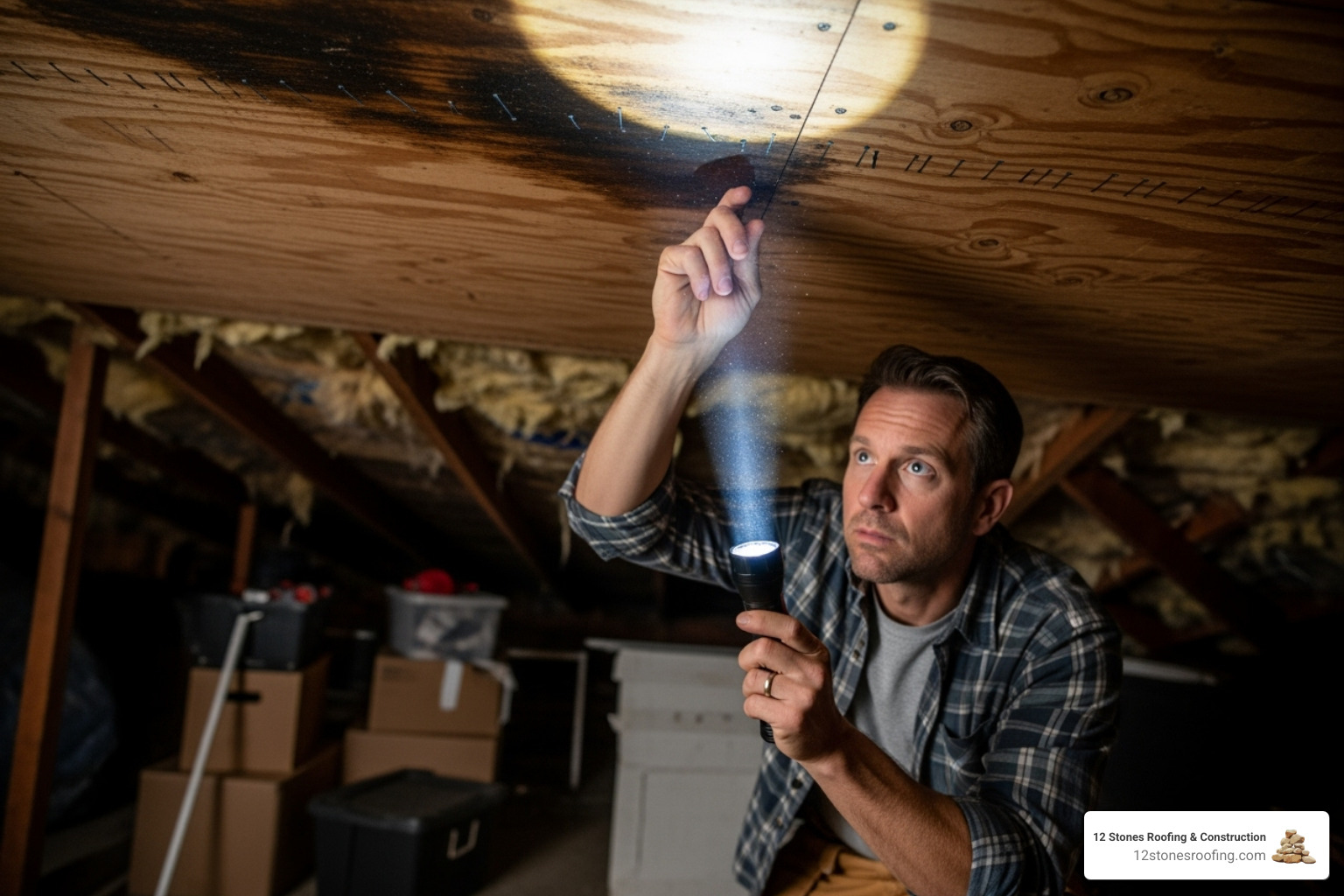
Early detection is the key to minimizing damage. Performing regular checks, especially after heavy storms, helps you spot trouble before it escalates. Think of it as a health checkup for your home—catching problems early means simpler, less expensive fixes.
Exterior Signs of Roof Damage from Rain
Your roof’s exterior tells a story. Learning to read the signs can save you thousands.
- Missing or Cracked Shingles: These gaps are open doors for water. Look for shingles that are curling, buckling, or out of place.
- Excessive Shingle Granules: Finding what looks like coarse black sand in your gutters means your roof’s protective armor is washing away, accelerating its deterioration.
- Damaged Flashing: Check the metal strips around chimneys, vents, and skylights for rust, cracks, or gaps. Flashing failure is a primary cause of new roof leaks.
- Sagging Roofline: A drooping or dipping appearance points to a serious structural issue from long-term water intrusion and rot. If you notice any sagging, call a professional immediately.
- Ponding Water: Water pooling on your roof for more than 48 hours indicates a drainage problem that will inevitably break down roofing materials. A professional roof inspection can pinpoint these issues.
Interior Signs of a Rain-Damaged Roof
Sometimes, problems announce themselves from inside.
- Ceiling Stains: Brown or yellow stains are the classic calling card of a leak. The leak’s origin may not be directly above the stain, as water travels.
- Peeling Paint: Moisture bubbling under paint on walls or ceilings means water has saturated the drywall or plaster behind it.
- Musty Odors: A persistent damp, earthy smell, especially in upper rooms, often signals hidden mold growth from a leak.
- Visible Drips: If you see water actively dripping, you have an active leak demanding immediate attention.
What to Do Immediately When You Find a Leak
When you find a leak, stay calm and act fast.
- Contain the Water: Place buckets under drips to collect water and use towels to protect your flooring. If the ceiling is bulging, carefully poke a small hole to release the water in a controlled way.
- Document Everything: Take clear photos and videos of the leak and all resulting damage. This evidence is invaluable for insurance claims.
- Call for Professional Help: Do not attempt to fix it yourself. Contact a professional for emergency roofing services. A qualified roofer can safely assess the situation, find the entry point, and perform temporary measures like roof tarping to prevent further damage while you arrange for permanent repairs.
Proactive Protection: Your Essential Roof Maintenance Checklist
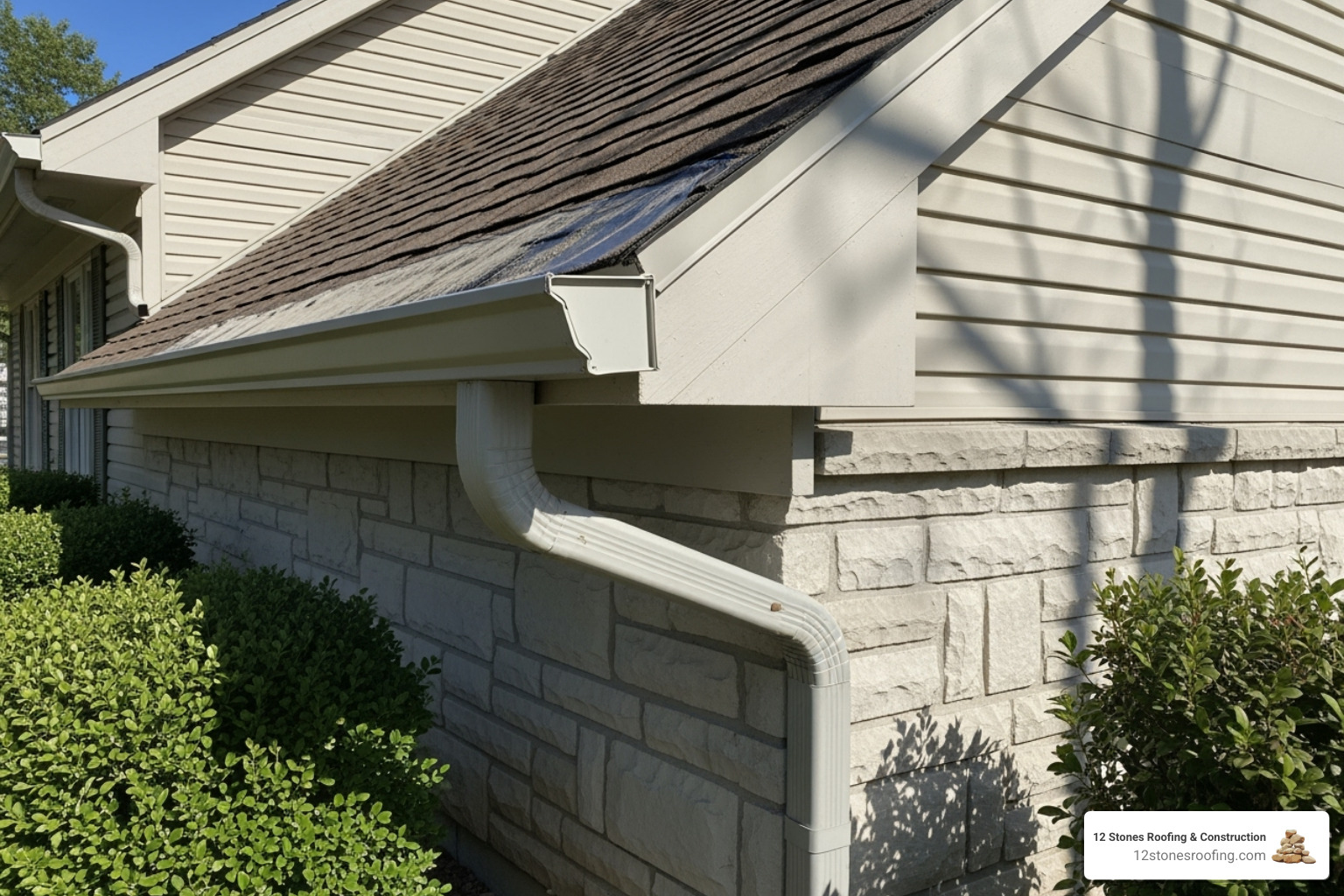
The best way to deal with a leak is to prevent it from ever happening. A proactive maintenance plan is your most powerful tool against roof damage from rain. Your roof deserves the same preventive care as your car’s engine.
The Critical Role of Gutters, Flashing, and Ventilation
Three components are critical to protecting your home from water intrusion.
- Clean Gutters: When gutters are clogged with debris, rainwater backs up under your roof edge, soaking the fascia and seeping under shingles. Clean them at least twice a year.
- Flashing Inspection: Roughly 40% of all roof leaks originate from compromised flashing. Inspect these metal seals around chimneys, vents, and skylights for rust, gaps, or cracked sealant.
- Proper Ventilation: A well-ventilated attic allows moisture to escape, preventing rot, mold, and structural issues. In Texas, good ventilation also prevents heat buildup that can prematurely age your shingles.
A Year-Round Plan to Prevent Roof Damage from Rain
Consistency is key for roof maintenance. You don’t need to be on your roof every week, but you do need a reliable schedule.
- Biannual Inspections: Every spring and fall, walk around your property and examine your roof from the ground. Look for missing shingles, dark streaks, or accumulated debris. You’re looking for changes since the last inspection.
- Trim Overhanging Trees: Keep branches at least six feet from your roof. Scraping branches wear away protective granules, and falling limbs can puncture your roof.
- Post-Storm Checks: After any major weather event, walk your property to look for obvious damage like displaced shingles or fallen branches. Catching issues early prevents them from becoming emergencies.
Following a comprehensive Roof Maintenance Checklist ensures you don’t overlook critical areas and transforms maintenance into a manageable routine.
What If It Rains During a Roof Installation?
A professional roofer will never install materials on a wet surface. Doing so compromises adhesion, traps moisture, and voids your warranty. If an unexpected shower occurs, a reputable crew will immediately tarp all exposed areas of the roof deck. At 12 Stones Roofing & Construction, we don’t start a project if there’s a 40% or greater chance of rain. Since about 30% of leaks in new roofs stem from installation errors, hiring a contractor with clear rain protocols is non-negotiable.
Frequently Asked Questions About Rain and Roofs
We often get questions from homeowners concerned about roof damage from rain. Here are some of the most common inquiries.
How can I tell if a leak is a minor issue or a serious structural problem?
A minor leak might be an isolated drip from a single cracked shingle. Signs of a serious structural problem are more extensive and include:
- A sagging roofline, which indicates damage to the decking and supports.
- Widespread water stains on multiple ceilings or walls.
- Persistent musty odors, pointing to long-term water intrusion and hidden mold.
- Daylight visible through the roof from inside the attic.
When in doubt, a professional assessment is the safest course of action. A Roof Inspection for Insurance can provide a definitive diagnosis.
How much does it cost to repair rain damage on a roof?
The cost to repair roof damage from rain varies widely. A simple fix like sealing flashing or replacing a few shingles might cost a few hundred dollars. However, extensive damage from a long-term leak—involving rotted decking, rafters, insulation, and drywall—could lead to a full roof replacement costing thousands. Prompt repairs are almost always more affordable.
Will my homeowner’s insurance cover roof damage from rain?
Coverage depends on the cause. Insurance generally covers damage from sudden, accidental events like a storm that tears off shingles. However, damage from lack of maintenance, gradual wear, or an old roof is typically not covered. Damage from natural flooding may also require a separate policy. Documenting your maintenance efforts is crucial for a successful roofing insurance claims process, as it shows you’ve taken reasonable steps to protect your property.
Secure Your Home Before the Next Storm
Your roof is your home’s primary shield against the elements. By understanding how rain causes damage, spotting the warning signs, and committing to proactive maintenance, you can prevent small issues from becoming costly disasters. The peace of mind from knowing your roof is sound is priceless.
Don’t wait for a storm to reveal your roof’s weaknesses. Most roof damage from rain is preventable with regular attention and professional care. A little maintenance goes a long way, and catching problems early means repairs that cost hundreds instead of thousands.
For over a decade, the expert team at 12 Stones Roofing & Construction has helped homeowners in Pasadena and the greater Houston area protect their homes. We understand the challenges Texas rain presents and offer comprehensive inspections to find vulnerabilities before they become emergencies. Our professional water damage repair services ensure any existing damage is properly addressed.
We believe in transparent, reliable service that gives you the full picture of your roof’s condition—no surprises, just honest assessments and quality workmanship. Our team adheres to the highest safety standards and uses materials that stand up to Texas weather.
Don’t leave your home’s protection to chance. If you’ve noticed any signs of roof damage from rain or simply have a nagging concern, we’re here to help. Call us today at (832) 702-3006 to schedule your free inspection. Let’s make sure your roof is ready for whatever comes next.




